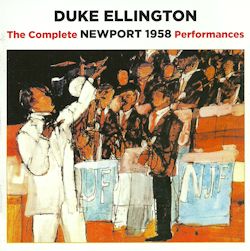CD1
1. Introduction by Willis Conover
2. Take The “A” Train [Theme]
3. Princess Blue
4. Duke's Place [C Jam Blues]
5. Just Scratchin' The Surface
6. Happy Reunion
7. Juniflip
8. Mr. Gentle And Mr. Cool
9. Jazz Festival Jazz
10. Feet Bone
11. Hi Fi Fo Fum
12. I Got It Bad (And That Ain't Good)
13. Bill Bailey, Won't You Please Come Home
14. Prima Bara Dubla
15. El Gato
CD 2
1. Multicolored Blue
2. Introduction To Mahalia Jackson
3. Come Sunday
4. Keep Your Hand On The Plow
5. Take The “A” Train [Theme]
6. Jones
7. El Gato [Studio Version]
8. Happy Reunion
9. Multicolored Blue
10. Princess Blue
11. Jazz Festival Jazz
12. Mr. Gentle And Mr. Cool
13. Juniflip
14. Hi Fi Fo Fum
15. Feet Bone
16. Just Scratchin' The Surfacet
Duke Ellington – Piano
Cat Anderson, "Shorty" Baker, Francis Williams – Trumpets
Cark Terry – Trumpet, flugelhorn
Ray Nance – Trumpet, violin, vocals
Britt Woodman, John Sanders, Quentin Jackson - Trombones
Jimmy Hamilton – Clarinet, tenor sax
Russell Procope – Clarinet, alto sax
Johnny Hodges – Alto sax
Paul Gonsalves – Tenor sax
Harry Carney – Baritone sax, clarinet, bass clarinet
Bill Graham – Alto sax (tracks II/7-14)
Jimmy Woode - Bass
Sam Woodyard - Drums
Gerry Mulligan - Baritone sax (track I/14)
Mahalia Jackson – Vocals (tracks II/3, 4)
Ozzie Bailey – Vocals (tracks I/4, II/1, 9)
Lil Greenwood – Vocals (tracks I/12, 13)
Mildred Falls – Piano (track II/4)
Conventional wisdom asserts that the Duke Ellington Orchestra was reborn at the 1956 Newport Jazz Festival. So it was no surprise that the band was booked
to appear there again in 1958. This album suggests that the ensemble had lost none of its adventurous spirit, especially in tracks like Princess Blue, which is as daring as any over-hyped contemporary group, especially in its voicings. Ellington often features individual musicians
with minimal accompaniments, where many arrangers would submit to the temptation of using the whole band most of the time. For example, Happy Reunion features tenorist Paul Gonsalves backed simply by the rhythm section.
To ensure clear sound quality, many of these tracks were freshly recorded in the studio, with applause tacked on. On this double CD you get both studio and
live performances to compare and enjoy. Highlights include Clark Terry’s saucy flugelhorm outing on Juliflip; Sam Woodyard’s drum feature inHi Fi Fo Fum (which borrows some licks from Louie Bellson’s Skin Deep); and Gerry Mulligan’s guest appearance on Prima Para Dubla, his baritone sax duetting with that of Harry Carney.
A memorable segment of the second CD features gospel vocalist Mahalia Jackson, expressively singing Duke’s Come Sunday and the old spiritual Keep Your Hand On The Plow. About a dozen of the tunes on this album were originals – many of them in the blues mode which Ellington varied so
well. This fact is reflected in the number of times that the word “blue” occurs in the song titles. Ozzie Bailey sings Multicolored Blue with
feeling, and Johnny Hodges supplies a typically soaring alto solo. Princess Blue illustrates how the Ellington band benefited from its roster of
star soloists – here Jimmy Hamilton, Russell Procope, Britt Woodman and Clark Terry.
The last two tracks on the second CD are bonus studio recordings taped in 1956, that fateful year when the band erupted into a fresh stage in its career.
That famous performance of Diminuendo and Crescendo in Blue reminded us of what we should never have forgotten: the pre-eminence of Duke’s band in
jazz.
Tony Augarde
www.augardebooks.co.uk
